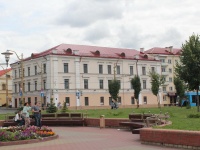- Home
- →
- Attractions
- →
- Palace «Batorievka»
Palace «Batorievka»
Batoryevka Palace is one of the main historical landmarks of the city of Grodno and an important monument of Italian Renaissance architecture. Built in the second half of the 16th century by order of the King of the Polish–Lithuanian Commonwealth, Stephen Báthory, the palace became not only his personal residence but also a center of the political life of the state. Today, “Batoryevka” is a must-see destination in the itineraries of many excursions across Belarus, especially those that include Grodno. Tourists can book an excursion with a visit to the palace to see with their own eyes the building where history was made, where the senate held sessions, and where key state decisions were made. Despite numerous reconstructions, “Batoryevka” retains its historical significance and attracts the attention of both researchers and travelers.
History of Construction
The appearance of the palace is associated with Stephen Báthory’s visit to Grodno in 1579. At that time, a session of the senate of the Polish–Lithuanian Commonwealth was being held in the city, dedicated to participation in the Livonian War. The king was impressed by the beauty and strategic location of Grodno and decided to make the city his personal residence. Báthory paid special attention to cultural and spiritual development: admiring the erudition of the Jesuit order, he invited them to the city and allocated a plot on the market square for the construction of a church and collegium. The eastern part of the square was designated for the monastic complex and palace, which became a political hub and the king’s residence during his stay in Grodno. Among locals, the building became known as “Batoryevka” in honor of its renowned owner.
It was in this palace that Stephen Báthory died on December 12, 1586. The king earned the nickname “Iron” for his robust health, and his sudden death sparked many rumors and speculations. One theory suggested poisoning. To determine the true cause, court doctors P. Simoni and N. Buccella engaged in a dispute, which was resolved when court barber J. Zigulitz performed an autopsy and embalmed the king’s body. This became the first anatomical autopsy in European history.
After Báthory’s death, the palace continued to serve as a royal residence and, from the early 18th century, became the property of the noble Sapieha family. In 1832, the building was reconstructed, and after a fire in 1885, its appearance changed dramatically once again. In the early 20th century, it housed a central hotel and the private gymnasium of K. Barkovskaya. Today, the building houses the Department of Normal Anatomy of the Grodno State Medical University and remains an important cultural heritage site.
Architecture of the Palace
The original architecture of Batoryevka Palace reflected the finest traditions of Italian Renaissance. The main building was two stories high, with a spacious hall on the second floor, illuminated by tall windows. This hall was used for significant state events and receptions of foreign ambassadors. The wing adjacent to the Jesuit church had three stories and likely served administrative purposes. The building was distinguished by symmetry, clean lines, and harmonious proportions, characteristic of Renaissance architecture.
In the 19th century, the building was reconstructed: only a few elements of the Renaissance style remained, while the main structure became three stories tall. The 1885 fire caused major damage, after which the palace was rebuilt again and lost its historical architectural appearance. In the 20th century, it was adapted to serve as a hotel and educational institution, which also affected its layout and appearance. Today, “Batoryevka” has a modest exterior resembling Soviet buildings of the 1950s, but the historical core of the building and its significance continue to attract the interest of researchers and tourists.
Excursions with Palace Visit
Batoryevka Palace is an essential part of tourist routes through Grodno and across Belarus. It is included in many excursion programs in Belarus as part of comprehensive tours that cover ancient churches, castles, and monasteries of the region. A particularly popular option is the excursion from Minsk, which allows visitors to discover the cultural and architectural heritage of western Belarus in just one day.
During the excursion, tourists explore the rich history of the building, learn about the political events of the 16th century, the role of the palace in the life of the Polish–Lithuanian Commonwealth, the tragic death of Stephen Báthory, and the first autopsy in European history. Tour guides will share detailed stories about the palace’s transformations, the history of its owners, and architectural changes. The palace visit is combined with tours of other significant sites in Grodno, making the experience especially immersive. Anyone interested can book an excursion in advance on the website ekskursii.by, choosing a convenient date and travel format.

